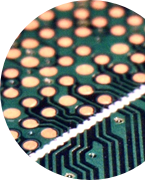

Vias are small holes that connect different layers of a printed circuit board (PCB). They allow for electrical signals to be routed between layers and are a crucial component in the design and functionality of a PCB.
There are three main types of vias: through-hole, buried, and blind.
Through-hole vias are the most common type of via and are the easiest to manufacture. They extend through the entire PCB, connecting the top and bottom layers. They are typically used to connect components that are soldered to the top and bottom of the PCB, such as connectors or switches.
Buried vias are vias that only connect internal layers of a PCB and do not extend through to the top or bottom layers. They are not visible from the outside of the PCB and are typically used to reduce the overall size of the PCB. This can be useful in compact electronic devices where space is at a premium.
Blind vias are similar to buried vias, but they only extend partially through the PCB, stopping before reaching the top or bottom layers. They are used to connect internal layers in a similar way to buried vias, but can also be used to connect surface mount components to internal layers.
When designing a PCB, it is important to consider the type of via that will be used, as this can have a significant impact on the overall functionality and performance of the circuit. Through-hole vias are generally considered to be the most reliable, while buried and blind vias can offer benefits in terms of size and cost, but may also be more difficult to manufacture.
In conclusion, Vias are an essential part of a PCB and it's important to choose the right type of via that will suit the design, purpose and budget of the PCB. Through-hole vias are the most common and easy to manufacture, Buried vias are used for internal connection and to reduce the overall size of PCB, blind vias are similar to buried vias but used for connecting surface mount components to internal layers.